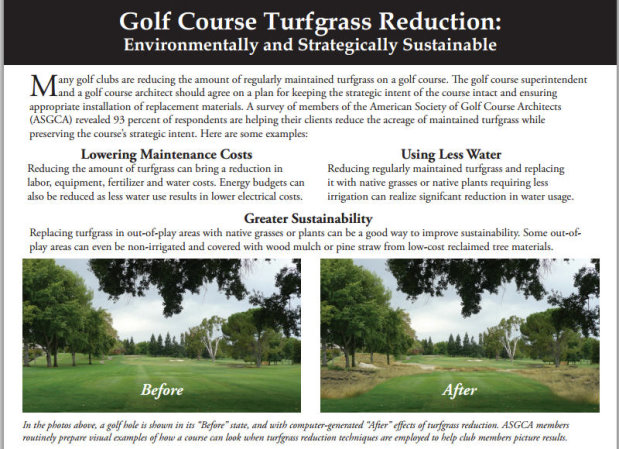 93% of American Society of Golf Course Architects members are helping clients reduce maintained turfgrass acreage; “Golf Course Turfgrass Reduction” flyer a good first step in addressing concerns
93% of American Society of Golf Course Architects members are helping clients reduce maintained turfgrass acreage; “Golf Course Turfgrass Reduction” flyer a good first step in addressing concerns
Golf course owners, managers and superintendents at private and public facilities are increasingly considering the reduction of maintained turfgrass on their course. American Society of Golf Course Architects (ASGCA) members work with these groups to create plans for keeping the strategic intent of the course intact and ensuring appropriate installation of replacement materials.
“There are more examples each month of courses looking to address maintained turfgrass,” ASGCA President Lee Schmidt said. “It’s a smart step to connect with an ASGCA member before beginning any project. The expertise and experience an architect provides will be beneficial from start to finish and positively impacts the project’s bottom line.”
The average ASGCA member has nearly 30 years of professional experience and worked or consulted on more than 150 projects. A project will benefit from an architect’s extensive background helping clients reduce acreage of maintained turfgrass while preserving the course’s strategic intent, and also improve course aesthetics due to additional contrast in color and texture.
Examples of the positive impact an ASGCA member can bring to turgrass reduction projects includes:
- Lowering maintenance costs – Reducing the amount of maintained turfgrass can bring a reduction in labor, equipment, fertilizer and energy costs. Energy budgets can also be reduced as less water use results in lower electrical costs.
- Using less water – Reducing regularly maintained turgrass and replacing it with native grasses or native plants requiring less irrigation can realize significant reduction in water usage.
- Greater sustainability – Reducing maintained turfgrass in out-of-play areas with native grasses or plants can be a good way to improve sustainability. Some out-of-play areas can even be non-irrigated and covered with wood mulch or pine straw from low-cost reclaimed tree materials.
ASGCA has created a “Golf Course Turfgrass Reduction” flyer, available for free download from the Publications section of the ASGCA website, www.asgca.org/publications. The flyer, endorsed by the Golf Course Superintendents Association of America, is a good first step for any course considering a turfgrass project. ASGCA www.asgca.org


